Gytheio
We start our tour of Gytheio from the old Girls’ School.
TIP: According to legend, after their fight for the tripod of the oracles of Delphi, Apollo and Hercules reconciled here in “Gyi Theon”, Gytheion, the land of Gods. The city, first recorded by Xenophon, was the port of ancient Sparta and later, during Roman and Frankish times, one of the main ports of southern Peloponnese
The Girls’ School
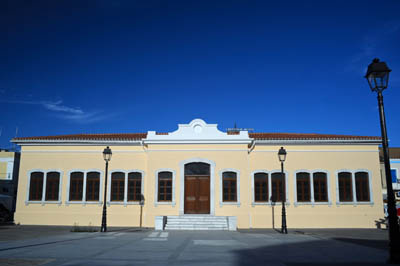
The building housing the Visitors’ Information and Interpretation Center of the Municipality of East Mani was built in 1891, probably by the Bavarian architect Ernst Ziller. For decades, it functioned first as a primary and later as a high school for girls. It is an important example of the late 19th century architecture and is therefore listed as a historical monument..
Going up Archaiou Theatrou Street, at the junction with Polyaravou Street you come across the Arfanis Building, considered a work of art for its neoclassical elements. On your right, at the junction with Dirou Street, there is the small church of Zoodochos Pigi.
Zoodochos Pigi (Panagitsa)
The Church of Zoodohos Pigi, the Life-giving Fountain, also known as Panagitsa, dates back to the early 20th century. It was built before the arrival of immigrants from Asia Minor in the region. On Easter Fridays, after Vespers, a procession of the church icon takes place from the village to the military camp.
TIP: On your left, at the junction with Dirou Street, you can see the building housing the Archaeological Collection of Gytheio. The collection consists mainly of findings dating back to the Roman period, found in the area during land and underwater excavations. You can visit the collection upon request.
Going up Archaiou Theatrou Street we cross the Refugee Neighbourhood.
TIP: This neighbourhood was built to house and takes its name from the 500 refugees who arrived in Gytheio in 1923, after the Asia Minor Catastrophe. Before their arrival, in the area, there were only the church of Zoodochos Pigi and one more buiding.
At the end of Archaiou Theatrou Street, you can see the Cook School Camp, the chapel of Agia Marina and the ancient theatre of Gytheio.
TIP: The chapel of Agia Marina is within the Cook School Camp and is only accessible on July 17th July, the day the saint is celebrated. On that day, a procession of the Holy Icon takes place around the camp and the edges of the refugee neighbourhood, while, on the evening of the same day, the command of the Camp gives a reception where all pilgrims are invited, at the Gytheio Guard Officers’ Club.
Ancient Theatre of Gytheio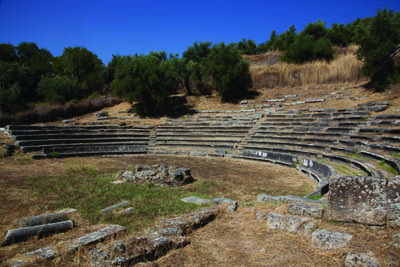
The Roman Odeon of Gytheio dates back to the 3rd century BC and was excavated in 1891 by the archaeologist Andreas Skias. The first six rows of marble seats, parts of the 7th and the 8th rows as well as part of the orchestra, the koilon of which had a diameter 75 metres long, are all well preserved. Here, during the summer, “Marathoniseia”, the festival of the Municipality of Gytheio, takes place. The festival, established in the late 1950s, now lasts for about a month and includes theatre, music, dance and children’s shows.
TIP: On the Acropolis hill, on the west, you can see the remains of the Roman aqueduct and the remains of an early Christian basilica dating back to the 3rd century.
Back on Apollonos Street, turn right into Polydefkous Street and at the end of it, on your left, you can see the Archaeological Site of Valaneion, the Roman baths of Gytheio.
Roman baths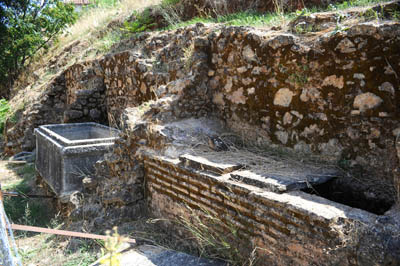
The three basic features of the Roman baths of Gytheio are still visible among the remains: a small rectangular room with a square notch that was used as a water tank for cold baths, a circular room with a cavity in the middle for a bronze boiler for tepid baths, and a “Warm Room”, a room for warm baths. These public baths operated from 8-9 am until sunset and guests had to pay a small entrance fee.
Go down Polydefkous Street, then turn right into Dimarhou Kalkandi Street and at the end of it, there is a rock that is said to have been the place where the Assembly made decisions in ancient times.
Go straight ahead until you reach Ermou Street, then turn right into the Gytheio – Sparta road until you come to the Gytheio prison complex, opposite the Roman cemetery.
The Gytheio Prison Complex
he Gytheio prison complex was constructed in early 20th century and functioned until 1972. Associated with the German Occupation and the Civil War, the two buildings of the complex were recently declared a monument of historical memory
Roman cemetery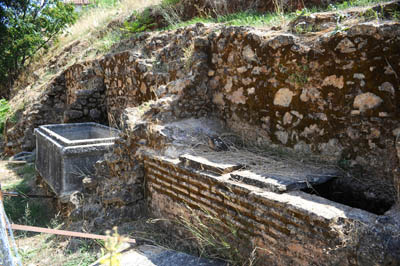
Most graves date back to the Hellenistic period and probably belonged to men who had been killed in battle. As rich grave goods were found in all of them, it is assumed that they were tombs of rich people.
To return to the city, go along Ermou Street until you come to the church of the Holy Trinity and its Events Hall.
Church of the Holy Trinity
During the feast of the Holy Trinity, a procession of the Holy Icon takes place round the limits of the parish and, after the Mass, the Church Council offers sweets and souvenirs.
Go straight along Ermou Street. At the junction with Orestou Street, you come across Georgopoulos Building, characterized as a listed building due to its remarkable neoclassical features.
TIP: Take a break and enjoy a “travihti”, a delicacy of the area, made with pieces of pork souvlaki and a slice of yellow cheese all wrapped in an oily pie! It will keep you full for the rest of the way!
Go down Orestou Street until you reach Vasileos Georgiou Street. Go on straight; Vasileos Georgiou Street is now called Vasileos Pavlou Street and it takes you to Perivolaki and to the War Memorial of Laconian Aviators.
War Memorial of Laconian Aviators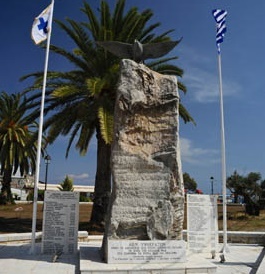
This monument was created by sculptor Praxitelis Tzanoulinos and was erected in 1979 in memory of the Laconian airmen who fell in the line of duty. On November 8th, the day of the feast of Archangels Michael and Gabriel, patrons of the Air Force of Greece, a memorial service and wreath laying is performed by the authorities, schools and relatives of the fallen Laconian Aviators.
TIP: In Perivolaki you can find aromatic herbs and olive tree varieties, used in educational programmes for young children about the export products of the region.
Go down Vasileos Pavlou Street until, on your right, you come to the Sanctuary of Zeus Kappota and Kapsaleia Library, a reading room of which is housed in the CIIEM..
Sanctuary of Zeus Kappota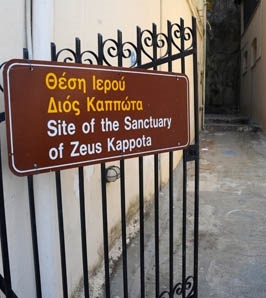
It is a carved stone which, according to legend, fell from heaven and healed Orestis, as soon as he sat on it, from the fury that had seized him. In Roman times, it was believed to be Zeus, who, transformed in stone, could heal pain.
Go down the street until you come to two of the most distinctive buildings of Gytheio: the Panagoulakeio Complex, a listed building bequeathed to Eastern Mani County, and the “Aktaion” hotel.
The “Aktaion” Hotel
Facing the beach, at the junction of Vasileos Pavlou Street with Laryssiou Street, it is considered a piece of art and, despite the recent renovation, it maintains its original architectural form.
TIP: After the 1896 Olympics, the Italian maestro Moretti arrived in Gytheio to lead the local Philharmonic. His love for music was such that he suggested that one child from every family in Gytheio, regardless of social class, should be trained to play a musical instrument. So every family had its own musician, with the mandolin being the most popular musical instrument.
At the beginning of Laryssiou Street, an ancient inscription marks the ancient street and invites you to walk the paved road with the old mansions, where, during Carnival, the Treasure Hunt and the Carnival parade take place!
TIP: On the last Saturday of Carnival, on Laryssiou Street, the Carnival is celebrated with a float parade, lots of colorful people and a lot of fun!
It is worth climbing up Agiou Dimitriou Street until you come up to at the Church of Agios Dimitrios, a point offering one of the finest views of the town.
Church of Agios Dimitrios
On the slope of Akoumaros, among the oldest houses in Gytheio, is the Church of Agios Dimitrios, a single-aisle basilica with a bell tower and Roman inscriptions. There, besides Agios Dimitrios, celebrated on October 26th, Prophet Elias is also celebrated, on July 20th.
Go back downhill to Laryssiou Street and to Filippakeio, an old mansion, opposite the Church of Agios Nicolaos (St. Nicholas).
Church of Agios Nicolaos
In the district called Lagadakia, opposite the island of Kranai, on December 6th, the day of the feast of St Nicholas, there is a procession of the Holy Icon from the church to the harbor, where a prayer for the health of mariners from Mani takes place.
To find your way back to the waterfront, turn right into Tzanimpei Grigoraki Street and climb down Marmarini Skala (the Marble Stairway), where you can see the bust of the poet Koulis Alepis.
TIP: The poet Koulis Alepis was born in Areopolis in 1903 and grew up in Gytheio. After finishing school, he studied Law and Philosophy at the University of Athens. His poems have been published in the most prestigious Greek, French and Italian literary magazines.
As soon as you are down the marble stairway, walk straight on until you come to the islet of Kranai, known as Marathonisi, connected to the mainland by an artificial narrow strip of land since 1898.
TIP: According to legend, Helen and Paris spent their first night in Kranai before leaving for Troy.
Next to the small beach of Chalkitsa, at the inlet of the island and near the church of Agion Petrou kai Pavlou (Saints Peter and Paul), is the old shipyard.
TIP: The shipyard was at its heyday during the years from 1936 to 1950, a period of time when wooden boats were used for the transportation of people and goods. The boats arrived at the shipyard once a year for maintenance. The replacement of the wooden boats with fiberglass boats signaled the decline of the shipyard of the island.
Go down the trail and, on your left, you can see the garden of the Tzanetaki Tower, which today houses the Historical and Ethnological Museum of Mani.
Tzanetaki Tower – Historical and Ethnological Museum of Mani
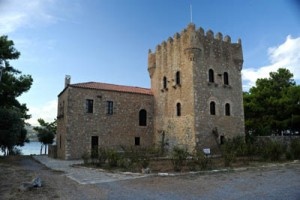
The Tzanetaki Tower was built in 1829 as a summer residence for Tzanimpeis Grigorakis, ancestor of former Prime Minister Tzanis Tzanetakis, who bequeathed the building to the Greek State in 1977. After being renovated by the National Tourism Organization, the Tower houses the Historical and Ethnological Museum of Mani, where you can find manuscripts, books and old maps showing the routes taken by foreign travellers who visited Mani from the Renaissance until the 19th century.
Go straight to the other end of the islet, where the Lighthouse of Gytheio has been standing for over a century.
The Lighthouse of Gytheio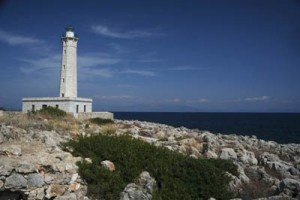
The 22-meter-high, white marble octagonal tower, built in 1880, was hit by a bomb during the Second World War and was repaired in 1949. A landmark for seafarers, the Lighthouse is a historical monument due to its characteristic architecture.
Back to the town waterfront, take a relaxing stroll and look at the view, have a drink or enjoy ouzo and meze at one of the numerous taverns.
TIP: In ancient times, Gytheio was famous for its exports of murex, which are still found in abundance in the area, especially in Kranai and Selinitsa.
The Poets’ Street, named this way in honour of Yiannis Ritsos and Nikiforos Vrettakos, takes you straight to the harbour where the Statue to the Unknown Sailor and the Mermaid stand and, to the left, to the Petrompeis Mavromichalis SquareTIP: At the Petrompeis Mavromichalis Square stop for a coffee or do your shopping. Do not forget to buy lupins, a local delicacy rich in proteins!
Statue of the Unknown Sailor
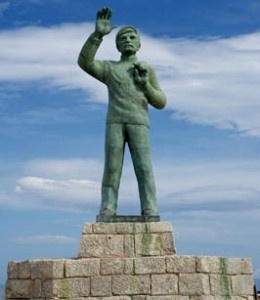
Dedicated to all the sailors who were lost at sea, the statue bears the inscription of two quatrains one by Ritsos and one by Vrettakos, the two poets from Gytheio.
The Mermaid of Gytheio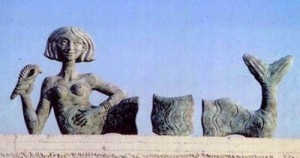
The Mermaid of Gytheion, the work of sculptress Rosa Iliou, was donated to the Municipality of Gytheio in 2005 by George and Menelaos Geroulakos, in memory of their father Konstantinos Geroulakos, a distinguished surgeon of Laconia.
TIP: The pier is an ideal spot if you want to take a spectacular, panoramic photo of the city!
Keeping on the waterfront, go past the listed Karvouni and Kalapotharakou Buildings and then return to the town centre, where you can make your last stop to admire the City Hall Building and, next to it, the High School where Yannis Ritsos and Nikiforos Brettakos studied.
Gytheion City Hall
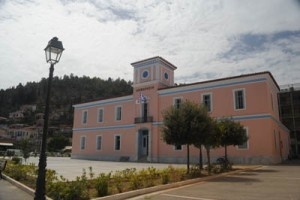
This building was built in 1891, probably by the Bavarian architect Ernst Ziller. A collection of important archaeological findings is temporarily housed here. In the past, the building housed the City Services, the Court the School of Commerce as well as the Evening High School. It is a listed, historical monument and an example of neoclassical architecture of late 19th century.
TIP: What’s better than a plunge into the sea at the end of the road?
The famous beach Selinitsa is just 15 minutes’ walk from the town centre (5 min by bike)!


